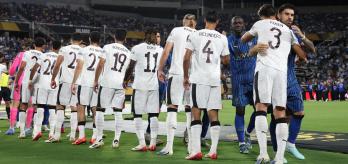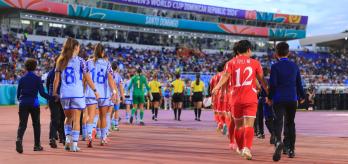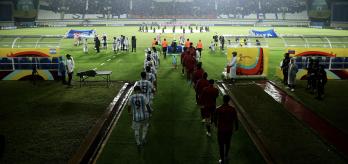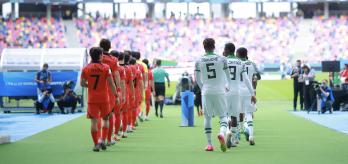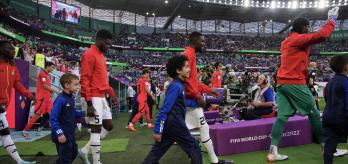Key take-aways
-
The relative age effect was present in Morocco, with 29.5% of participants at the FIFA U-17 Women’s World Cup 2025 born in the first quarter, while 21.6% were born in the final quarter. CAF was the only confederation with an over-representation in the final quarter (34.0%).
-
Most of the players at the tournament represented clubs within their own national association (86.7%). Morocco and Samoa were notable exceptions, with 19.0% and 0% playing at home, respectively.
-
Only 22.0% of players were affiliated with academic clubs, with stark regional contrasts: 0% in UEFA, 10.7% in CONMEBOL, and 12.4% in CAF, compared to over 50% in AFC and Concacaf, reflecting differing development models across the confederations.
Introduction
We analysed the dates of birth of the 504 players selected, their clubs and their countries of employment. We also compared the results obtained with those of the previous FIFA U-17 Women’s World Cup in the Dominican Republic in 2024.
This new edition increases the number of participating teams from 16 to 24 and the frequency (biannual to annual). The 24 teams represent all confederations with at least four nations, except for the OFC, with only two. Four associations participated in a FIFA U-17 Women’s World Cup final tournament for the first time (Côte d’Ivoire, the Netherlands, Norway, and Samoa), while five have previously won the crown, namely Korea DPR (three times), Spain (twice), as well as Korea Republic, Japan and France (once).
Players’ date of birth
An analysis of the birth dates of the selected players allows for an understanding of their distribution by year and month of birth.
Year of birth
In terms of year of birth, players born in 2008 represented the largest class with 64.9% (327 players), with the remaining 35.1% of players born in later years. 136 were born in 2009, 40 in 2010 and one in 2011 (Mayssa Baha of Morocco, who currently plays for FC Barcelona in Spain). In total, seven players started the competition aged under 15. With the exception of Korea DPR player Ri Ye-rim, all represent an African nation. When compared with the 2024 edition, the percentage per year of birth is almost identical, with 64.6% born in 2007 and 35.4% in later years.
This observation about the relatively young age of African teams is clear at the association level, where each country ranked at the top of the table with squad members typically under 17 years old. In contrast, four out of five European teams feature more experienced players. This issue also raises questions regarding the existence of U-15 or U-16 women’s national teams, which provide young girls with opportunities to demonstrate their talents at the highest level.
Relative age effect
The analysis by month of birth allows for the testing of the relative age effect (RAE). This concept refers to the typical over-representation of players born in the months immediately preceding the selected limit for defining an age category. In this case, the selection cut-off date is January. Generally, these players are at a competitive advantage due to their more advanced age, as well as physical and psychosocial development, compared to players born later in the year.
When the 12 months are divided into four birth quartiles, there is an RAE across the overall sample: 29.5% of players were born in the first quarter of the year (January-March), compared to 21.6% in the second quarter (April-June), 25.7% in the third quarter (July-September), and 21.6% in the fourth quarter (October-December). In contrast to Dominican Republic 2024™, the RAE has slightly intensified: 28.3% of players were born in the first quarter, compared to 26.5% in the final quarter.
Note: For this RAE analysis, we have removed three players whose date of birth could not be verified.
When the data is observed at the confederation level, there is an over-representation of players born in the first quarter of the year in Concacaf (35.7%) and the AFC (32.5%). Interestingly, CAF have an over-representation in the fourth quarter, with 34%. Players from UEFA associations are over-represented in the second quarter. However, the majority were born in the first half of the year (57.1% v. 42.9%).
Of the 24 teams, 14 had an over-representation of players born in the first quarter. Significant differences existed at the association level between the United States, where more than half of the players were born in the first quarter (52.4%). Meanwhile, in France, only two players were born between January and March (9.5%).
When considering player positions, goalkeepers are the only position in which players born in the first quarter are not over-represented, whilst it is strongest in forwards compared to others.
Clubs of employment
Type of clubs
Overall, 22% of the players selected for the FIFA U-17 Women’s World Cup 2025 are affiliated with an academic club. However, this percentage varies depending on how the training system is organised. The figures are particularly low in UEFA (0%), CONMEBOL (10.7%) and CAF (12.4%), where the best young female players in the country are integrated quickly into the ranks of professional or semi-professional clubs. They belong to sports organisations that participate in national adult competitions and are fully integrated into the sports system. By contrast, the relatively high percentage in the other confederations (54.8% in the AFC, for example) reflects the importance of high schools, universities, and private or association-affiliated academies in nurturing young talent.
Therefore, the high values at the top of the ranking can be explained. In Korea Republic, 16 players are affiliated with a local high school, participating in a competition organised by the Korean Football Association outside of the professional system. The other five players belong to Ulsan HD High School FC, which is affiliated with the professional club Ulsan HD. In China PR, all players are trained in regional academies organised by the Chinese Football Association, participating in national or regional youth competitions. Nine of the 21 Canadian players have been signed by the National Development Centre of Ontario, an organisation established by the Canadian Football Association to promote the development of women’s football. In the United States, most footballers are recruited by private academies or universities.
Of the 24 associations included in the study, 15 had fewer than 20% of their players competing in an academic club. All players selected by European nations are currently under contract with professional clubs, which employ young women in their youth teams and provide them with training. In the short term, these players will have the opportunity to join the first team and pursue a career in football.
In France, for instance, all players in the U-17 women’s national team are contracted to a club whose women’s (or men’s) team competes in one of the top two national divisions. They receive training in professional environments that are focused on competition. Morocco’s situation is similar, as a large proportion of its players currently play in Europe. In other African countries, national women’s leagues enable many young girls to join first-division clubs. Sometimes, the distinction between these types of structure is difficult to discern. In Cameroon, for instance, the Vision Foot Academy, which nurtures young talent, competes in the Guinness Super League, the top tier of women’s football.
Playing in the association represented
Regarding the proportion of footballers competing for clubs affiliated with their national association, 86.7% of participants in the FIFA U-17 Women’s World Cup fall within this category. The highest percentages were noted in the AFC (100%) and UEFA (97.1%), while the OFC reported the lowest (42.9%). This data demonstrates that the majority of players represent clubs within their national association, closely mirroring the 2024 figure of 88.7%, despite a significant increase in the number of teams. The lower proportions are primarily attributed to the selection of players born outside the country they represent. For example, several members of Morocco’s squad originated from large Moroccan communities based in Europe, with many either born abroad or having migrated as children. Samoa’s team was composed entirely of players residing and playing outside Samoa, predominantly in the United States, where a substantial Samoan population benefits from an established training system.
Very few participants were involved in football-related transfers at a young age outside of the Americas, where the United States’ system of combining academia with athletic training attracts teenagers. The only exceptions were two young Ivorians who were recruited by the Danish club FC Nordsjælland this past summer in partnership with the Right to Dream Academy in Ghana.
Diversity of employer clubs
Players who participated in the FIFA U-17 Women’s World Cup represented 249 different clubs worldwide. The allocation of players among these clubs differs according to the cultural context of each country and the selection approach of the respective associations. Some countries may emphasise professional clubs or educational institutions, while others may focus recruitment efforts on a smaller number of organisations. These strategies reflect the structure of the association’s sporting systems and can influence the degree of training background shared by selected players.
At the top of the table, the associations have no real dominant clubs. The USA had the lowest concentration of supplier clubs, with 18 involved in contributing towards the women’s national U-17 team. The country’s vast size and decentralised organisation result in a large number of clubs, both in terms of geography and structure. Samoa and Mexico are influenced by the same model because many of their players reside in the United States. In Africa, Nigeria, Côte d’Ivoire, and Zambia selected players from many clubs, highlighting the diversity and quality of their local teams.
At the lower end of the table, some national teams selected their squads from a limited number of clubs. Korea DPR operates a centralised system, where six clubs supply all 21 players, with the process organised by the state to promote the women’s teams internationally. This approach has resulted in wins at recent FIFA U-17 and U-20 Women’s World Cups. France and Italy take a similar approach, relying on several major clubs for their national teams, such as Paris Saint-Germain, Olympique Lyonnais, and Le Havre AC in France, and FC Internazionale Milano, Juventus FC, and AS Roma in Italy.
In other countries, player concentration was even more pronounced. For example, in Paraguay, the two leading women’s clubs based in the capital, Club Olimpia and Cerro Porteño, provided over 70% of the national team’s athletes. Similarly, in Ecuador, the women’s team of Independiente del Valle, known as Dragonas IDV, contributed nine players to the women’s youth national squad.
Conclusion
For the players of the FIFA U-17 Women’s World Cup, the RAE was still observed among the sample size, with 29.5% of players being born in the first quarter and 21.6% in the last quarter. Compared to the 2024 edition, the RAE increased slightly, where 28.3% of players were born in the first quarter, compared to 26.5% in the final quarter. When the data is observed at the confederation level, there is an over-representation of players born in the first quarter of the year in Concacaf (35.7%) and the AFC (32.5%). On the other hand, CAF had an over-representation in the fourth quarter, with 34%.
Although the RAE is recognised as a common phenomenon across many competitions, variations between confederations, and particularly among individual associations, cannot be attributed to a single explanatory factor. For example, Korea DPR and China PR, both employing highly centralised and productivity-oriented training systems, exhibited a significant proportion of players born in the first quarter. Similarly, the United States and Morocco demonstrated this trend despite possessing distinctly different training infrastructures. As the U-17 Women’s World Cup will now be hosted annually, considerations around the RAE will be important for member associations, as they try to balance tournament performance and developing long-term potential.
Only 22% of players in the FIFA U-17 Women’s World Cup were affiliated with academic clubs. Just six associations — China PR, Korea Republic, the USA, Samoa, Canada and Japan — have more than 30% of their players in such structures, which are independent of professional or semi-professional clubs. While professional clubs predominantly facilitate the integration of youth players into their programmes in Europe and South America, educational institutions frequently take on this responsibility in North America and Northeast Asia.
These regional differences were not reflected in the number of clubs engaged in player development. For example, just six clubs in Italy and Korea DPR accounted for the majority of team members, whereas 18 clubs participated in player development in the United States. This diversity can be attributed to the organisational structures and high-performance football environments within the respective associations. It is also important to note that 86.7% of the selected players were affiliated with a club within their national association. Samoa and Morocco are exceptions, with over 80% of their players based outside the countries they represented.









